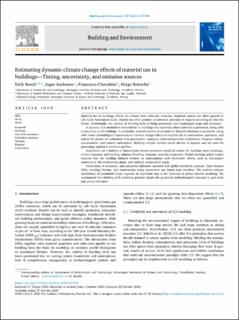| dc.description.abstract | Material use in buildings affects the climate over centuries, however, temporal aspects are often ignored in Life Cycle Assessment (LCA). Results too often promise uncontested precision of impacts occurring far into the future. Additionally, the validity of building LCAs is being questioned over inadequate scope and inventory.
A dynamic LCA method for material use in buildings that addresses those concerns is presented, along with a case study of 20 buildings. In particular, a novel solution to account for delayed emissions is presented, along with future technological improvements. Climate change effects of material use in construction, operation, and end-of-life phases are estimated, from production, transport, construction-waste incineration, biogenic carbon-sequestration, and cement carbonation. Building subpart metrics reveal drivers of impacts and are used for generating statistical emission profiles.
Application on a bottom-up harmonized dataset produces statistical results for building types (typology, timber/concrete) and building subparts (building elements, material categories). Global warming policy targets requires that the building industry focuses on interventions with short-term effects, such as low-impact materials in the construction phase and reduced construction waste.
Uncertainty is estimated, and parameter influence assessed with global sensitivity analysis. Time horizon (TH), building lifetime, and construction waste parameters are found most sensitive. The method reduces uncertainty of postulated future impacts; an important step in the direction of policy-relevant modeling. We recommend that building LCA modeling practice adopts the presented methodological concepts to gain trust and policy-relevance. | en_US |

